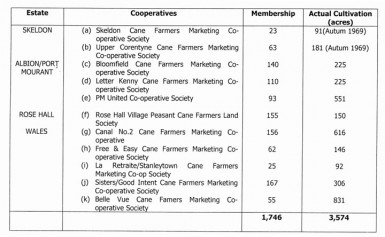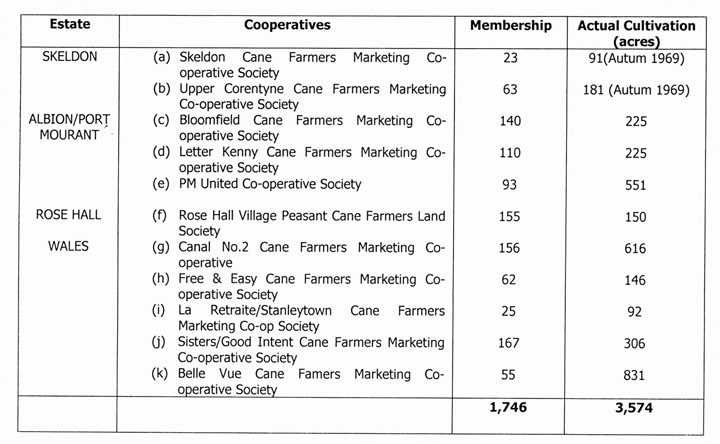Dear Editor,
To those who have paid varying degrees of attention to the fortunes (?) of the sugar industry, the reported invitation by the President for “ideas” to rescue it from the admitted “crisis,” must be cause for confusion, coming immediately after the announcement of the installation of a new Executive Chairman (who scarcely deputised), charged with the responsibility of leading GuySuCo’s management team to a gratifying level of productivity. Having pondered thereon, they must feel compelled to dismiss the several earlier meandering rationalisations of ministers cryptically said to be ‘responsible.’
Again they must wonder about what may have been the exotic notion of a cooperativised sugar industry – even though it is totally consistent with the ideology of a Cooperative Republic.
But for readers to go past the plenitude of soundbites, it may be helpful for them to better understand the pass to which the industry has now come, by being reminded of how the journey began.
Ethos of the GuySuCo Strategic Plan (1998-2008)
At a special ACP Ministerial Conference in Jamaica in April 1996, the then Head of the Sugar Division of the European Union had this to say:
“The changed import regime will gradually reduce the preference for EU and ACP sugar … will increase the pressure in the EU market price. This could lead to the reduction of the … ACP guaranteed price in the annual price review … Sugar producers in the EU and in the ACP states should use the time and good conditions now to rationalise and modernise their production in preparation for increased competition worldwide.”
In 1998 GuySuCo adopted a long-term strategic approach to secure the future of Guyana’s sugar industry. This was approved by the Government of Guyana as a Strategic Plan for the industry.
GuySuCo’s Chairman in his statement in the 1999 Annual Report remarked on the enthusiastic reception given the plan by “most multilateral institutions, our major customers, commercial bankers, and members of the diplomatic community.”
The Chairman went on to highlight the main features of the plan as follows:
* Increase production to 500,000 tons in two phases
* Decrease average cost to below USȼ 17/lb
* Extend Caricom market coverage and size
* Develop new regional markets
* Add value through special sugars, co-generations, distillery and refinery (if feasible)
* Work to develop intra-Caribbean markets for refined sugar
The plan also envisaged the following initiatives concentrated at Skeldon Estate:
i) Expanded cultivation, significantly including private cane farmers’ construction of a refinery
ii) Establishment of a distillery
iii) Co-generation of electricity for sale to the national grid
iv) A new factory capable of producing 110,000 tonnes of sugar annually 1999 which completed Year 1 of the plan was touted as a record-breaking year for GuySuCo with production at 321,438 tonnes at cost of production of USȼ 17.63/lb. Institutional memory did not go as far back as 1971 when a total of 369,000 tonnes was produced. For that matter in the early 1960s the production was as follows:
1961 – 334,441
1962 – 324,745
1963 – 362,023
1964 – 317,137
1999 was therefore a promising foundation upon which to build the future. Indeed the year’s results well befitted the corporation’s new Mission Statement, as follows:
“To be a world class industry producing high quality sugar and added value by-products, while ensuring customer satisfaction, employee development, environmental protection, and safe working practices. In so doing we will achieve growth and sustained profitability in order to contribute to the economic and social development of Guyana.”
The plan was informed by two major considerations:
i) GuySuCo’s contribution to Guyana’s economy in terms of foreign exchange earnings
ii) GuySuCo’s cost of production – aimed at USȼ 12/11 per/lb
GuySuCo also planned to add value by way of packaged special sugars including golden granulated, standard Demerara, and light Muscovado. A decision was made to concentrate initial development investment in the lower cost Berbice estates, and to enlarge factory capacities at Skeldon and Albion that would benefit from economies of scale.
In terms of the expansion of the cane cultivation, it was reported that 2,120 hectares (ha) were identified in the Manarabisi area, while another 6,000 ha were located between Skeldon cultivation of 4,000ha and Canje. Total estate expansion would therefore have been in the order of 12,000ha (with 4,000ha apportioned to private cane farmers) signalling an increase of sugar production from 350,000 to 400,000 tons.
Based on its 1999 performance optimism was high in the industry, but production varied over subsequent years, eg, 2000 ‒ 273,703 tons; 2002 – 331,180 tons; 2007 – 266,482 tons; 2009 – 238,806 tons.
By 2009, one year after the end of the initial Strategic Plan, a Strategic Blueprint was devised for the period 2009-2013. It asserted that the strategies involved were intended to transform the industry’s cost base and develop motivated teams that would contribute to the production of 400,000 tonnes of sugar by 2013.
Interestingly, the targeted cost per ton of production was revised as follows:
YEAR USȼ per lb
2009 27.7
2010 23.2
2011 21.2
2012 20.4
2013 19.6
The above being a far cry from the USȼ 17.63/lb of 1999.
But by June 24, 2011 GuySuCo’s CEO in Stabroek Business lamented on the ‘Blueprint’ as follows:
i) Loss of skilled and experience personnel as one of the factors that had impacted negatively on GuySuCo’s field operations since 2004.
ii) The rate of resignations and migration had resulted in a level of skill losses that sometimes
compelled the administration to promote other employees to higher positions before they were
adequately equipped to assume responsibilities – notably in the areas of “agriculture and fac
tory”
iii) “The rate of losses has left the corporation depleted of key skills with very few choices for
replacements and promotions.”
iv) The corporation has consequently been affected by “poor decision-making in the field and
factories through lack of experience and the general decline in the quality of management.”
v) The propensity for a “high number of strikes.”
vi) Being “faced with greatly reduced windows of opportunity for getting the field work
done.”
What is new about co-operatives in the sugar industry?
For the purpose of providing an informed perspective, please note the existence of the following Cane Farmers’ Co-operative Societies:
 Transactional relationships between all registered cane farmers and the “Manufacturer” estates were dictated by the National Cane Farming Committee Act. In particular, the price of cane sold and bought was computed on an inflexible formula initially advised by the industry for inclusion in the regulations to the Act. However, other farming groups such as those still existing at Buxton, BV/Triumph and Plaisance were not included in this new arrangement.
Transactional relationships between all registered cane farmers and the “Manufacturer” estates were dictated by the National Cane Farming Committee Act. In particular, the price of cane sold and bought was computed on an inflexible formula initially advised by the industry for inclusion in the regulations to the Act. However, other farming groups such as those still existing at Buxton, BV/Triumph and Plaisance were not included in this new arrangement.
Since the Guyana sugar industry was nationalised, there was no further deliberate effort to expand small cane-farming up until GuySuCo’s first Strategic Plan (1998-2008) conceived the significant expansion of farmers’ cane cultivation from 300 acres only, to 30% of Skeldon Estate’s planned agricultural expansion.
Any resort to co-operatives as a (randomly) envisaged mechanism for the restoration and growth of the sugar industry must be better organised than the corporation, by its own admission, is today.
For example, the ministers so far involved, as well as the executive management of GuySuCo, have studiously avoided recourse to the National Cane Farming Committee Act, Cap 69:04, and related regulations, when doling out favours to selected cane farmers.
The legislation provides for the establishment of a National Cane Farmers Committee with membership as follows: (Section 3 of the Act):
a) “eight persons chosen by the Minister from among farmers who have been recommended for appointment by District Associations:
“Provided that until such time as District Associations have been established under section 8, the Minister may appoint any farmer for any district;
b) three persons chosen by the Minister from a panel of seven nominated by the Association;
c) five official members; and one person nominated by the Development Corporation.” (This is now defunct.)
Perhaps, however, the most critical aspect of the Act is the contract which must be entered into between the “manufacturer” (the respective sugar estates) and the cane farmer. The Act stipulates that a contract must be entered into between a “farmer” and a “manufacturer” for the “cultivation, sale and processing of sugar cane.”
This remarkable piece of legislation demands that the relationships between “farmer” and “manufacturer” be legally solemnized, with the clear implication that any default by the parties concerned will constitute a breach of the law.
It is reasonable to expect that for there to be any substance to the “Enmore declaration” regarding greater ‘cooperative’ participation in, and even management of, components of the sugar industry, OP will have to organise a competent task force to flesh out and update the current legislation to ensure its relevance to the vision of worker/cane farmer participation in the sugar industry.
The President’s latest declaration also appears to open other operational components of the sugar industry to the cooperative model of management, the factory being a possible attraction to rum-makers. Remember also the announcement in Stabroek News of April 13, 2012 under the caption: ‘Brazilian Company to develop plant at Albion Estate,’ which reported that “… the Agriculture Minister is optimistic about the future of GuySuCo, since … the company is successfully confronting the challenges it is currently facing.”
All in all it is an opportunity to be seriously explored by all those who are committed to the revitalisation of the sugar industry.
Yet caution requires equally serious reflection on earlier blandishments ‒ like the following from Kaieteur News of August 20, 2011:
“The government yesterday bluntly admitted that the Guyana Sugar Corporation (GuySuCo) does not have the management expertise to run the Skeldon Sugar factory and is seriously looking at hiring either a foreign company (Chinese or Indian) to manage the estate.
“The Minister of Agriculture, Robert Persaud, said that the success of the sugar industry rides on the success of the Skeldon factory, which was commissioned two years ago at a cost of US$181 million.”
In the final analysis the President’s call is not new. For ever since June 2012, he was reported in the Guyana Chronicle:
“President Donald Ramotar on Saturday last reiterated his call for unity in the sugar industry and commitment to working with the industry and all associated stakeholders to ensure that it continues to play a central role in the economy in order that many of the services that were provided in the past, can continue.”
Yours faithfully,
EB John






